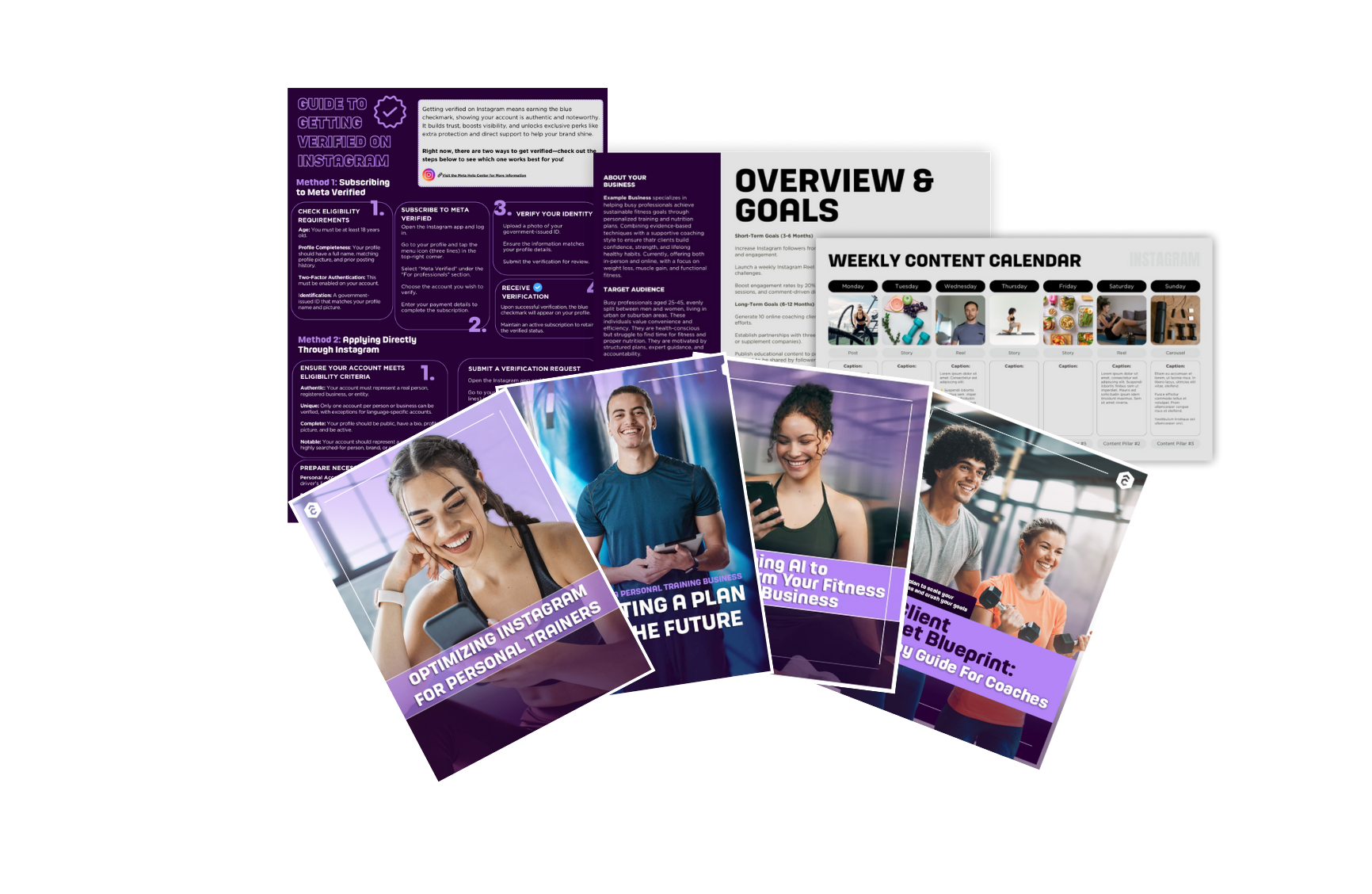Yep, we understand all too well that keeping up with your marketing and social media posts takes time and energy. Which is exactly why you want to make sure that all of your marketing efforts are carefully considered and planned out to ensure they are working hard to create a strong online presence, build relationships with your audience, and drive traffic to your business.

It’s no exaggeration that a well-thought-out content strategy is the backbone of social media success for personal trainers.
Social media can be overwhelming, and it’s often hard to see the results of your efforts. So we’ve put together some steps you can take to ensure stellar content performance, automation of processes, and the growth of your audience.
👉 Accept that you need a content strategy
We know, it’s another thing to add to your epic to-do list. But this one is worth the time, we promise! Not only will having a strategy around your social media posting make it easier for you to know what you’ve already covered, what you needto cover, and when you need to do it, it can also significantly contribute to the success and growth of your coaching business.
A content marketing strategy helps maintain consistency in the type of content shared, the tone used, and the visual elements presented. This consistency reinforces your brand identity, making your personal training business easily recognizable and memorable to your audience.
The strategic planning and creating of content allows you to engage your audience with a variety of well-chosen posts including:
- Polls
- Conversation starters
- Information and tip sharing
- Showcasing your expertise
- Nutritional or workout advice
- Reposted memes and jokes relevant to the industry
- Much more!
Most importantly, it will save you time and headaches in the long term.
👉 Know your audience
If you don’t know who you are trying to reach and how your content will captivate them, you’ll just be scrambling for ideas and struggling to think of what to post, which ultimately takes up more of your precious time.
Understanding your target audience is essential for social media success. Once you understand the specific needs, preferences, and pain points of your audience, you can build a content strategy framework that enables you to tailor your messages. This targeted approach increases the likelihood that your content resonates with the right people.
Some ways to find out more about your target audience include:
- Respond to comments and messages and pay attention to what people are saying and what grabs their attention.
- Ask directly using polls, question stickers, and surveys. This interactive content encourages participation and provides valuable feedback.
- Use the analytics tools available on the various platforms (such as Instagram Insights) to track demographics (age, gender, location, etc), interests, and behaviors.
- Review metrics such as likes, comments, and shares to identify the type of content that generates the most engagement.
- Create buyer personas that represent typical clients.
If your personal training business specializes in strength training, you’ll want to find out what content will specifically appeal to those kinds of customers.
👉 Create content buckets
This is where you can have fun and get a sense of what kinds of posts you need. Content buckets are really just categories. By dividing your content into these buckets you ensure that you maintain variety, consistency, and engagement. It’s a guide to structuring your content in order to stay organized and focused.
Each bucket represents a specific aspect of the overall content strategy, catering to different interests and needs of the target audience.
Example of content buckets include:
Educational: Inform and educate your audience with how-to videos, tutorials, ebooks, infographics, case studies, tips and tricks, posts related to fitness, nutrition, or specific exercises.
Promotional: Promote your services, products, or special offers using announcements of new programs, discounts, client testimonials, and success stories. You should aim to make about 20% of your social media content promotional.
Behind-the-Scenes: Humanize your brand and provide a glimpse into your daily life with behind-the-scenes videos or photos of your workouts, training sessions, meal prep, social media creation, or a day in the life.
Inspirational/motivational: Inspire and motivate your audience using inspirational quotes, motivational stories, transformation stories, and messages of encouragement.
Entertaining: Amuse and delight your followers with memes, throwbacks, contests and giveaways, jokes, funny videos and reposted content. Though you can stray occasionally, any entertaining content should be related to the fitness/wellness industry.
User-generated content: Show your community spirit by providing useful, original, brand-specific content created by your customers such as blog post comments, podcasts, reviews and Facebook comments or posts. The great thing about UGC is that someone else has done the creating – just be sure to credit or link appropriately.
SEO (search engine optimized) content: Rank highly in search engines with posts that contain strategically placed keywords to drive website traffic and raise brand awareness.
This helpful article contains more information on the types of buckets you can create.
Check out this article for ideas on what kinds of content you can produce to fill your buckets.
Streamline your workflow by creating content in batches. Dedicate specific times for content creation and use those sessions to produce multiple posts in one go.

👉 Set a posting schedule
Again, there’s no benefit to posting content willy-nilly. You need to create a content calendar (or editorial calendar) to determine how often you should post and what type of content should be shared when.
Once you’ve chosen your social media platforms, identified your target audience, and developed your content buckets, you can decide how often you’ll post on each platform. Consider factors such as the platform’s algorithm, your audience’s online habits, and your capacity to create quality content. This calendar should include the date, time, content type, captions, and any accompanying images or videos.
Note any special events, holidays, or promotions that you want to incorporate into your content calendar. Plan themed posts around these dates.
Create a calendar template by utilizing a spreadsheet or calendar tool. Include columns for dates, content type, captions, hashtags, and any links or multimedia elements.
Let’s use the example of a coach specializing in strength training. Here is an example of posts they could create:
Post 1: Educational Content
Caption: “Strengthening 101: Understanding Progressive Overload 🏋️♂️”
Content: Share a visually appealing image or infographic explaining the concept of progressive overload in strength training. Include tips on how to progressively increase weights and intensity for optimal muscle growth.
Post 2: Workout Demo
Caption: “Full-Body Strength Workout! 🔥 Swipe left for each exercise breakdown. Save and try it out during your next gym session!”
Content: Create a carousel of images or a short video demonstrating key strength-training exercises such as squats, deadlifts, and bench presses. Include concise instructions for proper form and technique.
Post 3: Client Success Story
Caption: “Meet Thor – A True Strength Warrior! 🌟 Read their inspiring journey on the deadlift. Dedication and hard work pay off! #StrengthGoals #ClientSpotlight”
Content: Share a before-and-after image or a video testimonial of a client who has achieved significant strength gains under your guidance. Highlight the client’s dedication, progress, and the positive impact of strength training.
Post 4: Quick Tip
Caption: “Quick Tip Tuesday: Boost Your Squat Strength! Focus on driving through your heels, engage your core, and maintain a neutral spine for a powerful squat. Ready to elevate your squat game? Let’s do this! 👊 #SquatForm #StrengthTrainingTips”
Content: Share a brief video or image providing a quick tip on improving squat form for better strength gains.
Post 5: Nutrition Advice
Caption: “Fuel Your Strength: The Power of Protein! 🥩 Did you know that protein is crucial for muscle repair and growth? Share your favorite protein-packed meal in the comments! #ProteinPower #StrengthNutrition”
Content: Share a visually appealing image of a protein-rich meal and provide a brief caption highlighting the importance of protein in supporting strength training goals.
Post 6: Motivational Quote
Caption: “Monday Motivation: Strength doesn’t come from what you can do; it comes from overcoming the things you once thought you couldn’t. Let’s conquer new challenges together! 💪 #StrengthJourney #MotivationMonday”
Content: Share a visually appealing graphic with an empowering quote related to strength and overcoming challenges.
Post 7: Live Q&A Session
Caption: “Ask Me Anything! Join me live this Monday at 7pm for a Q&A session on strength training. Got questions about form, programming, or overcoming plateaus? Drop them in the comments below! 👇 #StrengthQandA #LiveSession”
Content: Host a live Q&A session on your preferred social media platform, addressing questions related to strength training and interacting directly with your audience.
The above list was created with the help of AI, which you can also use to help you create your own content calendar. Read our blog post ChatGPT: your new fitness business buddy for helpful tips on making the most of this tool.
Remember to periodically review the performance of your posts and adjust your content calendar accordingly. Pay attention to engagement metrics, comments, and any shifts in audience behavior.
👉 Automate the process
Don’t do every little thing manually like a chump! You’re far too busy for that and your time is best spent with your clients.
Find the right tools for scheduling posts and tracking performance to streamline the process, save time, and maintain a consistent online presence.
- Choose a social media management tool that aligns with your needs and preferences. Popular options include Hootsuite, Buffer, Later, Sprout Social, and CoSchedule.
- Connect your social media accounts to the chosen management tool. This typically involves authorizing the tool to access your social media profiles.
- You will have already created (or should now create) your content calendar with your dates, times and content information.
- Take advantage of the scheduling features provided by the social media management tool. Schedule posts for specific dates and times based on your content calendar.
- Customize your posting schedule to align with the time zones of your target audience. Many tools offer insights or recommendations on optimal posting times. Some tools allow you to create a queue where posts are automatically scheduled at predefined intervals. Or you could use bulk scheduling to upload multiple posts at once.
- For evergreen content (content that remains relevant and valuable to audiences over an extended period, often without becoming outdated) or recurring themes, use the tool’s features to schedule posts to be automatically reposted at regular intervals.
- Regularly review the analytics provided by your social media management tool. Track and measure engagement, reach, and other relevant metrics to assess the effectiveness of your posts.

👉 Trainer see, trainer do
We recommend you find your own style and rhythm; you want to stand out and be original after all! However, it is absolutely beneficial to learn from other successful fitness related accounts on social media, especially those that you admire or that operate in your niche area.
Analyze the social media activity of other personal trainers or fitness influencers to see what kind of content resonates the most.
A successful social media account will:
- Diversify their content (use the buckets!)
- Post regularly and consistently
- Give their audience what they want
- Surprise their audience on occasion
- Make the most of other influencers and user-generated content
- Base their content calendar around their business goals
Some industry success stories you could investigate include:
- Kayla Itsines (SWEAT)
- Simeon Panda
- Michelle Lewin (Fitplan and Mealplan)
- Jen Selter
- Joe Wicks (The Body Coach)
- Lauren Kagan
- Dannella Munoz
- Emily Skye
Good luck with creating your own successful content marketing strategy. There’s plenty of help out there on the net, including this article and this one.
TrueCoach also has a great webinar to download: Creating a Content Machine: How To Gain Attention As A Coach
About TrueCoach:
TrueCoach is the industry’s best workout builder that makes it easy for personal trainers and coaches to grow their business while delivering an exceptional experience for their clients. With its user-friendly interface and time-saving features, TrueCoach is the ideal choice for personal trainers looking to streamline their workflow.
To further enhance your content strategy and streamline your coaching business, consider using an app for personal trainers designed to help you manage clients and grow your online presence efficiently.
Get Started With a
Free 14 Day Trial
Enter your email to try TrueCoach completely risk-free.
- No credit card required.
- Cancel any time.

Recommended Resources For You

Resource
Grow Your Business With Social Media
Author: Clare Hudson
Everything you need to take the guesswork out of social media. Start turning your followers into paying clients today.

Blog
Do You Need A Large Social Media Following to Be a Successful Online Coach?
Author: Andrew Coates
Coaches with large social media followings love to tell you that you don’t need a large social media following to be a successful online coach. Are they right? Technically yes(though it can help – more on this later). What really matters? Relationships with people that like and trust you who know what you do. And […]

Blog
How to Promote Your Fitness Business on Social Media as a Personal Trainer
Author: Bobby O’Connell
In today’s digital age, social media has become an indispensable tool for personal trainers and coaches. It’s not just about posting workout videos or motivational quotes; it’s about building a brand, engaging with your audience, and driving real business results. If you’re a personal trainer or health and wellness coach looking to expand your reach […]

Author: Bobby O'Connell FRSA CSM
-
First published: January 08 2024
Written by: Bobby O'Connell

